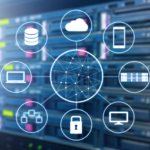The time has come to say goodbye to your outdated legacy business application and hello to faster, more efficient technology.
Migrating data from a legacy system to a new application isn’t a simple export and import. In this blog post, we’ll explain the risks of a mismanaged migration and provide four tips for success.
Why You Need to Migrate Your Legacy System
Legacy systems are outdated applications businesses rely on for daily operations. They include everything from project management and time logging apps to accounting software and sales CRMs.
There are several downsides to holding onto legacy applications:
- Efficiency: Legacy applications slow down business. Ever struggle with data taking forever to load? Continually rebooting computers? Struggling to get your remote employees secure access to the data they need? Legacy applications aren’t equipped to deal with the modern needs of today’s workforce and hurt productivity.
- Security: Old IT assets are often overlooked when it comes to security. Without proper patching and updates, they’re a significant cybersecurity liability.
- Repair costs: It’s not an easy fix when legacy application breaks. Many vendors don’t offer support for outdated software and IT teams may not have the technical expertise to repair them, incurring huge costs and disrupting business.
4 Tips to Successfully Migrate Legacy Data
Seventy-five percent of new software programs don’t meet user expectations because of failures in the data migration process.
Most businesses don’t have the expertise to prepare and migrate their old data to a new application. (In fact, only 19 percent of business owners believe their team could handle the task.)
Don’t become a victim of an unsuccessful migration. Here are four tips to successfully migrate legacy data.
1. Account for Every Step in The Migration Process
First, you need to understand the steps involved.
It’s not just about the technical requirements. What are the business goals of the migration? Who will be involved in the project? Do you have a plan for training and onboarding staff to the new technology? What about ongoing maintenance and support? How will the application integrate with your other apps?
It’s easy to focus on the migration itself and skip the planning phase. Make sure you take the time to understand every step in the process, your business goals and ongoing maintenance and support to ensure you get the most out of your migration.
2. Engage Power Users and Key Players Early On
Powers users are the employees who use the system every day. They know how your old application works — and all of the tricks required to operate it.
Power users are a great source of feedback to ensure the new application provides the best user experience and has all the required features.
Migrating to a new legacy application shouldn’t be contained in an IT silo — a new application can affect how the entire company operates. Engaging power users early on minimizes mistakes and ensures a successful post-migration adoption.
3. Allocate Sufficient Resources
Legacy data migration is a complex activity that requires substantial investment, training and time commitments. Don’t underestimate the time, money and human resources required.
Make sure to work with your IT staff to allocate resources for planning, migration, onboarding and ongoing IT support and training for staff after the migration.
4. Prioritize Data Quality
Data quality drives successful migrations. No two systems are alike. Your old application could use data for one purpose while the new program uses it for another.
Let’s say your legacy system has a mandatory field for customer birthday. It helps your salespeople maintain a personal relationship with your customers. However, your salespeople don’t use this feature, so they enter random dates.
In your new system, customer birthdays are used to send out gift cards. Unless your migration team knows about this critical usage difference, you’ll spend money you didn’t budget. (And customers will think you don’t remember their birthday.)
Retiring redundant data before migration can also help you save on storage costs and increase application speed.
To avoid data quality issues, make sure all data is:
- Relevant: Fit for the target system’s intended purpose
- Accurate: Free of error and verified
- Complete: Contains all necessary information and be easily read by the target system
- Consistent: Data used for the same purpose has a uniform structure
- Valid: Within the limits of the type of data you can collect
- Timely: Up-to-date and available when needed
- Accessible: Can be exported to the target location
- Compliant: Satisfies all legal requirements and industry standards
Legacy Migration Services With Helixstorm
Migrating your legacy application doesn’t have to be a headache.
At Helixstorm, we have over 50 years of collective industry experience. Our team of migration experts will audit your existing infrastructure, identify areas to consolidate and design a seamless roadmap to migrate your application seamlessly to the cloud.
Call us today and take the first step toward a successful legacy migration!



